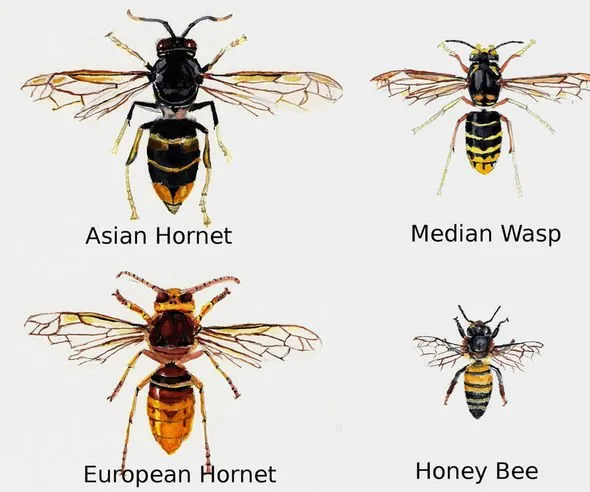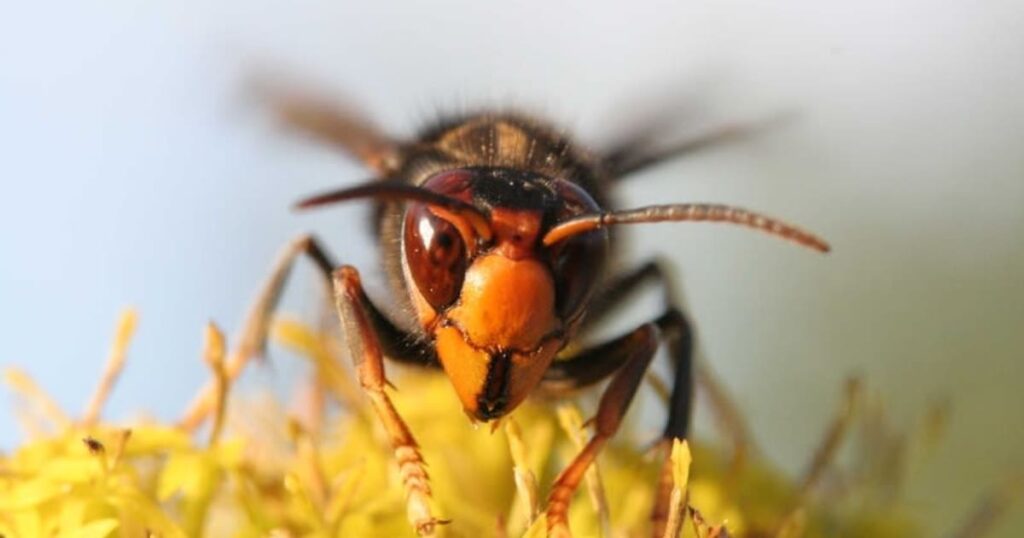The blog in June set out to answer a few questions on wasps – the usual pest of the summer. It’s been widely reported over the last few weeks that this seems to be the summer without wasps, thanks to the unusually cold and wet weather.
But there is one insect pest that will not go away, and that’s the Asian hornet. Last April we described the threat that these insects pose to British bees and gave links to the website where people are encouraged to report any sightings. The news at that time was that there had been two sightings in 2022 – both in the east of England – and a possible sighting in Cornwall in March 2023.

The bad news…
2023 saw the highest number of Asian hornets sightings so far. There were 57 confirmed sightings of Asian hornets and 73 nests destroyed. The majority of those were in Kent, with several in East Sussex and Hampshire, two in London and one in Southend. More than one nest was found in about half of those sightings, with fourteen nests destroyed in Folkestone in one August fortnight. If you remember, the starting point for these insects to invade a new country is through ports and airports, so the south coast of England is going to be their main target.
But we have ports in this region, too.
- Ships dock at Tilbury, Felixstowe and Ipswich every day, most of which have passed within a few miles of the French coast (where the Asian hornet is firmly established).
- Small yachts sailing home from Germany, France and the Netherlands arrive in marinas along the Essex and Suffolk coast every day in summer.
- Stansted is the fourth-busiest airport in the UK, with several planes a day arriving from mainland Europe.
With all these entry points, I’m surprised that there haven’t been more Asian hornet sightings in Essex and Suffolk. If there’s no sightings because there are no hornets getting this far, that’s great – if it’s because people have forgotten to keep an eye out for these pests, that’s a worry.
The really bad news
The National Bee Unit is monitoring this threat on behalf of The Animal and Plant Health Agency, and as part of that process it records the DNA of Asian hornets captured in the UK. Three queen Asian hornets caught in East Sussex in April 2024 are direct descendants of a nest destroyed six miles away in Rye last November. This is the first evidence that Asian hornets have survived the winter here. That’s the first step to becoming established in this country.
Hawking and Hunting
An Asian hornet can eat thirty to fifty bees each day. Their habit of ‘hawking’ (hovering outside the hive entrance) can cause the indirect deaths of many more as the bees are unable to leave and return safely with food for those inside. Asian bees have some amazing and effective strategies to protect themselves against these predators, but British bee colonies haven’t had the chance to learn these yet.
Don’t Give Up
The fight against Asian hornets goes on. DEFRA, the Animal and Plant Health Agency, the National Bee Unit and the British Beekeepers’ Association are still waging war on this pest. The National Bee Unit has placed traps in areas where there is a particular risk that the Asian hornet has survived the winter (in Kent, East Sussex, Devon and North Yorkshire). These traps are designed to imprison Asian hornets while allowing other insects to escape.

If you (or somebody you know) keeps bees, this is old news to you. There are traps available to buy if your local beekeeper is concerned about Asian hornets coming to kill their bees, although I would advise buying from a reputable bee supply company to make sure you get a well-designed trap.
Report EVERY sighting
I’m not going to apologise for repeating what I said in last year’s blog, because it is still valid and more important than ever. There have been twenty confirmed sightings up to the end of June 2024, and if 2023 is anything to go by, August and September will be far worse. Of the 57 2023 sightings, 22 were in August and 18 in September.
So – Asian hornets look like this;
- Around 25 to 30 mm long (smaller than European hornets)
- Black head with an orange ‘face’
- Black upper body
- Black lower body with a bright orange segment near the sting
- Yellow legs
- Their nest is egg-shaped, swirly-patterned and roughly half a metre long
- Active between April and November, especially in August and September.
- Excellent photo at https://www.bbka.org.uk/asian-yellow-legged-hornet
If you think you have spotted an Asian hornet or its nest, you must report it. Take a photo if you can and report an accurate time and location of the sighting through the Great Britain Non-Native Species Secretariat website at www.nonnativespecies.org or by email to alertnonnative@ceh.ac.uk.
Don’t let these pests get a foothold in the UK.

